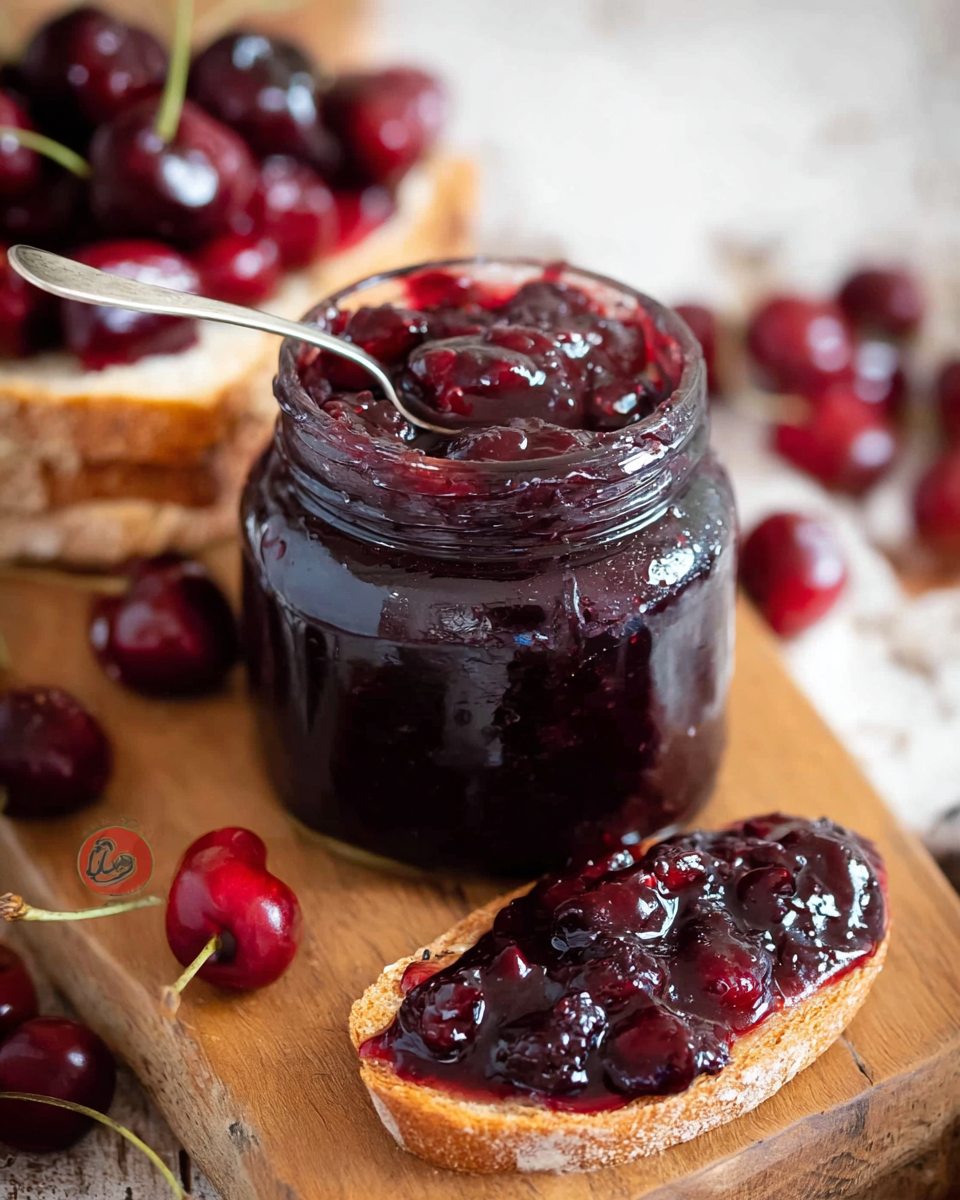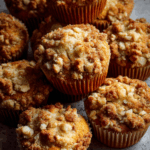This homemade cherry jam is a delightful, naturally sweet spread made without any added pectin. Using ripe cherries and simple ingredients, this jam achieves the perfect balance of sweetness and tartness with a rich, thick texture that’s ideal for toast, pastries, or as a topping for yogurt and desserts. The slow simmering process helps extract the cherries’ natural pectin, eliminating the need for commercial additives while preserving vibrant flavor and color.
FULL RECIPE
Ingredients
- 4 cups fresh pitted cherries (sweet or tart)
- 1 ½ cups granulated sugar
- 2 tablespoons fresh lemon juice
- 1 teaspoon vanilla extract (optional)
Directions
- In a large heavy-bottomed saucepan, combine the pitted cherries, sugar, and lemon juice. Stir to mix evenly.
- Let the mixture sit for about 30 minutes to macerate, allowing the cherries to release their juices.
- Place the saucepan over medium heat and bring the mixture to a gentle boil, stirring frequently to prevent burning.
- Reduce the heat to medium-low and simmer uncovered, stirring occasionally, for 30 to 45 minutes until the jam thickens and reaches a jam-like consistency.
- To test, place a small spoonful of jam on a chilled plate; if it wrinkles when pushed with a finger, it’s ready.
- Remove from heat and stir in vanilla extract if using.
- Carefully ladle the hot jam into sterilized jars, leaving about ¼ inch of headspace. Seal the jars while hot.
- Allow to cool completely before storing in the refrigerator. The jam will continue to thicken as it cools.
Nutrition Facts
- Calories: 70
- Protein: 0.3g
- Fat: 0g
- Saturated Fat: 0g
- Carbohydrates: 18g
- Fiber: 1g
- Sugars: 16g
- Sodium: 0mg
Health Benefits of Cherries
Cherries are not only delicious but also packed with health benefits. They are rich in antioxidants, particularly anthocyanins, which help fight inflammation and may reduce the risk of chronic diseases such as heart disease and arthritis. Cherries also contain vitamin C, potassium, and fiber, which support immune function, regulate blood pressure, and aid digestion. Including cherry jam in moderation can be a flavorful way to enjoy these benefits while satisfying your sweet tooth naturally.
Why Make Jam Without Pectin?
Traditional jams often rely on added pectin to achieve the desired gel-like texture. However, many fruits, including cherries, contain natural pectin that can be extracted through cooking and the addition of acidic ingredients like lemon juice. Making jam without commercial pectin results in a more natural product with fewer additives. It allows the true flavor of the fruit to shine through and gives you greater control over the sugar and texture.
The Importance of Lemon Juice in Jam Making
Lemon juice plays a crucial role in jam making, especially when skipping added pectin. Its acidity helps activate the natural pectin in the fruit, ensuring the jam sets properly. Additionally, lemon juice balances the sweetness with a subtle tang, enhancing the overall flavor. It also acts as a natural preservative, helping to extend the shelf life of your homemade cherry jam.
Choosing the Right Cherries for Jam
Selecting the right cherries is key to making flavorful jam. Tart cherries such as Montmorency provide a bright, tangy flavor that balances the sweetness, while sweet cherries like Bing yield a richer, more mellow jam. Using fresh, ripe cherries ensures maximum flavor and natural pectin content. If fresh cherries aren’t available, frozen cherries can also work well, just be sure to thaw and drain excess juice before cooking.
Natural Thickening Without Additives
This recipe’s method of simmering cherries slowly allows the natural pectin and fruit sugars to concentrate and thicken the jam. The process requires patience, but the result is a clean-tasting jam without artificial thickeners. This slower approach also helps maintain the vibrant color and fresh flavor of the cherries, offering a wholesome alternative to store-bought jams loaded with preservatives.
Variations and Flavor Enhancements
Cherry jam is wonderfully versatile and can be personalized with additional flavors. Adding a cinnamon stick, star anise, or a splash of vanilla during cooking imparts warm, aromatic notes. For a citrus twist, orange zest or a splash of Grand Marnier can be stirred in after cooking. For a spicy kick, a pinch of chili flakes or ground ginger can add depth. These variations allow you to tailor your jam to your preferences or pair it with specific dishes.
Serving Suggestions
Cherry jam is a classic breakfast staple, perfect spread over toast, bagels, or English muffins. It also makes an excellent topping for pancakes, waffles, and yogurt bowls. Beyond breakfast, cherry jam can elevate desserts like cheesecake, ice cream, or pound cake. Use it as a glaze for roasted meats like pork or duck, or swirl it into salad dressings and sauces for a hint of natural sweetness and tartness.
Storage and Shelf Life
Proper storage is essential to preserve the quality and safety of homemade cherry jam. Store the jam in sterilized, airtight jars and refrigerate after opening to prevent spoilage. When sealed and refrigerated, the jam typically lasts up to three weeks. For longer storage, you can freeze the jam in freezer-safe containers for up to six months. Always use clean utensils to avoid contamination and monitor for any signs of mold or off smells.
Homemade Jam Versus Store-Bought
Making your own cherry jam offers several advantages over commercial options. Homemade jam typically contains fewer preservatives, artificial colors, and excess sugars, allowing you to customize sweetness and texture. The fresh fruit flavor is more pronounced, and you can avoid additives like high-fructose corn syrup. Additionally, homemade jam supports sustainability by reducing packaging waste and utilizing seasonal produce, making it a more environmentally conscious choice.
Tips for Successful Jam Making
Successful jam making requires attention to detail and patience. Use a heavy-bottomed pan to prevent burning, and stir frequently during simmering. Avoid rushing the cooking time to ensure the jam thickens naturally. Testing the jam’s set by placing a spoonful on a chilled plate helps determine readiness. Always sterilize jars before filling to prolong shelf life. Lastly, label your jars with the date to keep track of freshness.
Advertisement
Cultural Significance of Cherry Jam
Cherry jam has a long tradition in many cultures, often symbolizing the arrival of summer and the celebration of fresh fruit harvests. In European countries, it is a beloved homemade staple passed down through generations, frequently made in large batches to enjoy throughout the year. This tradition highlights the importance of seasonal cooking and preserving food naturally, connecting us to simpler, slower culinary practices.
Conclusion
Homemade cherry jam without pectin is a rewarding kitchen project that captures the essence of fresh fruit in a sweet, versatile spread. It offers a healthier, more natural alternative to store-bought jams and invites creative flavor variations. From its nutritional benefits and cultural roots to practical serving and storage tips, this recipe enriches your culinary repertoire with both taste and tradition. Making cherry jam at home celebrates the joy of preserving seasonal produce while savoring pure, homemade goodness.






